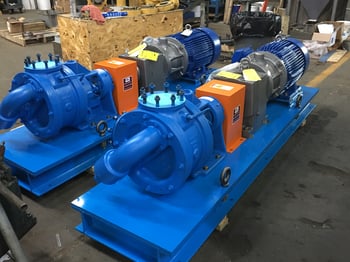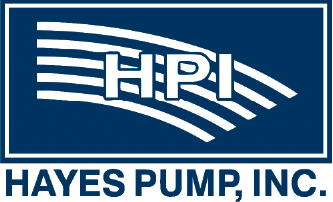Different Types of Pumps
.png?width=2000&height=1046&name=Hayes%20Pump%20Blog%20Featured%20Image%20(5).png)
Pumps are essential tools used in various industries, including manufacturing, construction, and agriculture. They play a crucial role in moving liquids from one location to another, making them an integral part of many processes.
However, not all pumps are the same. Several types of pumps serve different purposes and have unique features. This blog will discuss the different types of pumps, their uses, and their benefits. By the end, you'll better understand which type of pump suits your specific needs and factors to consider when choosing one.
Pump Types and Examples
End Suction Pumps
Pumped liquid increases velocity as it moves along the impeller's vanes. Then, the liquid moves into the volute casing, where a diffusion process converts the high velocity to high pressure.
ANSI Pumps
The only pumps in the US that are dimensionally standard as deemed by the American National Standards Institute.
Non-metallic (Lined and Sealed) Pumps
Withstand a wide range of severe service applications by being corrosion-resistant and abrasion-resistant.
Mag Drive Pumps T
Their primary feature is that the motor shaft does not extend into the interior pump, eliminating the need for a shaft seal that prevents leakage, lowering the maintenance cost.
Sump Pumps
Usually installed in sump pits, where water flows into the sump pit through drains or by natural migration through the soil.
Axial Flow Pumps
Consists of an axial impeller in a pipe that can be driven directly by a sealed motor.
Vertical Turbine Pumps
Designed to move water from a deep underground well.
Vane Pumps
Best at handling low-viscosity liquids. Have no internal metal-to-metal contact.
Pulp & Paper Process Pumps
Perfect for the pulp and paper industry, known for tough, abrasive processes.
API Process Pumps
Meets the American Petroleum Institute standard for pumps handling hydrocarbons.
Split Case Pumps
The casing is split into two separate chambers, which is less costly for high-flow applications. Bearings on both sides can support the impeller.
Double Suction Pumps
Receive suction liquid on both sides of the impeller, which balances the thrust of the impeller.
Multi-Stage Pumps
Utilize multiple impeller and can be mounted on the same or different shafts.
Rotary Gear Pumps
Meshing of gears pumps the fluid through displacement. Example: +Viking Pumps
Centrifugal Pumps
Utilizes an impeller to move water and many other liquids.
Air-Powered Piston Pumps
Use high-pressure air to power or move the piston.
Abrasive Slurry Handling Pumps
Capable of handling high amounts of abrasive solids and mixtures.
Sanitary Pumps
Used to transport food and agriculture in operations that require cleanliness. Example: +Wrightflow Technologies
Self-Priming
A type of centrifugal pump that uses an air-to-water mixture.
Air Operated Double Diaphragm (AODD)
Uses compressed air as a power source. Example: +Warren Rupp Sandpiper
Factors to Consider When Choosing a Pump
 Selecting the right pump for your specific needs is a critical decision that can significantly impact your operations' efficiency and cost-effectiveness. Here are some essential factors to consider when choosing a pump:
Selecting the right pump for your specific needs is a critical decision that can significantly impact your operations' efficiency and cost-effectiveness. Here are some essential factors to consider when choosing a pump:
- Pump Type: As we've discussed, numerous types of pumps are designed for specific applications. Understand each pump's unique features, advantages, and disadvantages to identify the most suitable type for your needs.
- Material Compatibility: The pump materials should be compatible with the pumped liquid to prevent corrosion and wear. Consider the liquid's properties, including its temperature, viscosity, and whether it contains abrasive or corrosive substances.
- Flow Rate and Pressure: These are two of the most important factors. Your selected pump should be capable of achieving the desired flow rate and pressure to meet your system's requirements.
- Energy Efficiency: Consider the pump's energy usage. More energy-efficient pumps can lower your operational costs in the long run.
- Installation and Maintenance: Evaluate the ease of installation and the level of maintenance required. Some pumps might be cheaper upfront but could incur higher maintenance costs over their lifetime.
- Reliability and Lifespan: The pump's reliability and expected lifespan are also vital considerations. Look for pumps from reputable manufacturers and read reviews to gauge their performance and durability.
- Cost: Finally, consider the total cost of ownership, including the initial cost, installation, maintenance, and energy costs. The cheapest pump may not necessarily be the most cost-effective in the long term.
By considering these factors, you can make an informed decision, choosing a pump that fulfills your requirements, delivers optimal performance, and offers the best value.
Why Trust the Pump Experts for Your Pump Selection Needs
The variety and versatility of pumps within the industries are vast. Each type has its unique features, advantages, and applications. Understanding these differences is crucial in choosing the right pump for your specific needs. We hope this detailed guide has provided you with insightful knowledge about the diverse world of pumps, helping you make an informed decision. Remember, the right pump can streamline your operations, reduce maintenance costs, and enhance productivity. If you have any further questions or need assistance selecting the most suitable pump, please contact our team of experts anytime. We're here to help!




